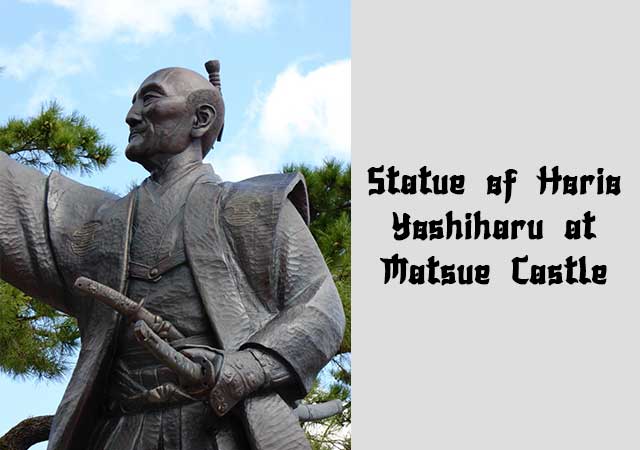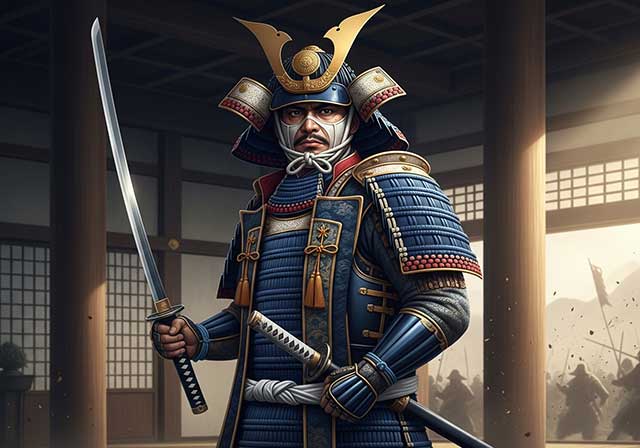
Horio Yoshiharu, also known as Horio Mosuke, was born in Niwa-gun, Owari (Aichi Prefecture) in 1542. Due to his serene composure and the ability to maintain tranquility even in the most intense situations, he earned the nickname "Hotoke no Mosuke," or "The Buddha Mosuke," after the enlightened deity, Hotoke.
Yoshiharu's father once served as a vassal in the Iwakura Oda clan, rivals of Oda Nobunaga. However, after Nobunaga defeated their clan, Yoshiharu's father became a Ronin, a samurai without a master. The Sengoku period was an era of constant life-or-death struggles for samurai. Remaining composed under pressure and concealing one's thoughts and emotions were crucial skills to avoid betrayal. It was during these early days that Yoshiharu likely honed his Buddha-like calmness and mental fortitude for survival. Fortunately, he would later find employment under Nobunaga, albeit in a modest role as a foot soldier.
The pivotal moment that brought Yoshiharu to Nobunaga's attention happened during a hunting excursion in Owari. A massive wild boar charged the hunting party, causing everyone to scatter—everyone except Yoshiharu. Unarmed, he stood his ground and wrestled with the beast. Nobunaga was greatly impressed by Yoshiharu's calmness, strength, and courage, which led to his promotion. Yoshiharu's blend of bravery and serenity served him well in subsequent battles, earning him widespread admiration.
As the nation was on the brink of the Battle of Sekigahara in the late summer of 1600, and alliances were fracturing into Eastern and Western factions, Yoshiharu attended a drinking gathering in Chiryu, Mikawa Province, with Lord Mizuno Tadashige of Kariya Castle and Kaganoi Shigemochi. The discussion about war and allegiance escalated, culminating in a drunken and enraged Kaganoi killing Lord Mizuno and injuring Yoshiharu. Despite his wounds, Yoshiharu calmly and effectively took control of the situation, demonstrating a Buddha-like composure. He administered justice by confronting Kaganoi and restoring peace. It is said that Yoshiharu sustained seventeen wounds from Kaganoi's spear during the skirmish, rendering him unable to participate in the Battle of Sekigahara. Instead, his son took his place on the battlefield.
Following Sekigahara, the Horio clan was granted land in Izumo Province (Shimane Prefecture) and assumed control of Matsue Castle as Daimyo. Yoshiharu entered retirement at this post. Although his son Tadauji succeeded him, he succumbed to illness in 1604. Tadauji's heir, a nine-year-old named Tadaharu, was considered too young to assume the role, prompting Yoshiharu to once again take on the responsibilities until his grandson was ready to lead.
Horio Yoshiharu embodied both courage and skill in combat, all while exuding the calm and enlightened spirit of a Buddha—an invaluable trait for samurai navigating the razor's edge of the Sengoku period.
See also
-
Uemura Masakatsu

Masakatsu was a member of the Uemura clan and the son of Uemura Masatada; from an early age he served Tokugawa Ieyasu. During the Ikkō-ikki uprising in Mikawa Province in 1563, having converted from the Jōdo Shinshū Buddhist sect to the Jōdoshū sect, he took part in suppressing the rebels. After these events, Masakatsu was appointed a military governor and was granted land holdings. According to a number of sources, he was one of the so-called “Three Governors of Mikawa” (Mikawa sanbugyō), together with Amano Yasukage (1537–1613) and Koriki Kiyonaga (1530–1608).
-
Tomoe Gozen

Gozen is regarded as one of the few historically documented examples of true female warriors of feudal Japan, known as onna-musha or onna-bugeisha. Although Japanese history records countless women who at various times were forced to take up arms—for example, in defense of their castles—Tomoe Gozen was, without any doubt, a genuinely skilled and accomplished fighter. She was the wife of Kiso (Minamoto) Yoshinaka, although The Tale of the Heike describes her more as a female vassal. Yoshinaka rose in rebellion against the Taira clan and, in 1184, captured Kyoto after his victory at the Battle of Kurikawa. After the Taira were driven into the western provinces, Yoshinaka began insistently asserting that he alone was worthy of assuming leadership of the Minamoto clan and taking on the mantle of its head.
-
Tachibana Muneshige

Tachibana Muneshige was born the eldest son of Takahashi Shigetane, one of the principal retainers of the Ōtomo clan and commander of Iwaya Castle. In childhood, he bore the name Senkumamaru. His early years coincided with a period of intense military confrontation between the Ōtomo clan and other powerful warrior houses of Kyūshū—namely the Shimazu, Akizuki, and Ryūzōji clans.
-
Tachibana Dosetsu

Tachibana Dōsetsu is the name by which Hetsugi Akitsura is more widely known; the name of this lineage is also found read as Hekki or Bekki. For a long period, Akitsura served the Ōtomo clan, the daimyō of Bungo Province, and took part in wars against the Ōuchi family, the principal enemies of the Ōtomo in northwestern Kyushu. In the 1560s, Akitsura seized the castle of the Tachibana clan, which had rebelled against the Ōtomo, and thereafter adopted the surname Tachibana. Around the same time, he took Buddhist vows and assumed the name Dōsetsu, which means “Snowy Road.”
-
Taira no Masakado

Taira no Masakado embodied the quintessential samurai of his era—self-assured, harsh, and unyielding. In his youth, he served in the palace guard and repeatedly proved his bravery while suppressing unrest. Thanks to these achievements, Masakado sought the post of chief of the capital’s military-police office (the kebiishi-chō), but he was rejected: by that time, nearly all court positions—now little more than privileged sinecures—were controlled by members of the powerful Fujiwara clan.
-
Sakakibara Yasumasa

Yasumasa was the second son of Sakakibara Nagamasa and was born in Ueno in Mikawa Province. From a young age, he began serving Tokugawa Ieyasu and eventually rose to the position of one of his most trusted generals. His wife was the daughter of Osuga Yasutaka. Ieyasu first noticed the young Yasumasa during the suppression of the Ikkō-ikki uprising in Mikawa in 1564. Thanks to his demonstrated abilities, Yasumasa was granted the privilege of using the character “yasu”—the second character of Ieyasu’s own name—in his own. Although he was the second child in his family, he became his father’s heir, though the exact reasons for this remain unknown.
-
Sakai Tadatsugu

Tadatsugu was one of the most renowned generals serving Tokugawa Ieyasu. After Ieyasu broke ties with the Imagawa clan, Tadatsugu—an ardent supporter of this decision—was granted command of Yoshida Castle in 1565, which controlled the coastal road from Tōtomi to Mikawa. During the Battle of Mikatagahara in 1573, he held the right flank of the Tokugawa forces even when the troops sent by Oda fled under the assault of the Takeda army. In the Battle of Nagashino in 1575, he personally requested permission to carry out a night attack on the Takeda camp, which he executed brilliantly together with Kanamori Nagachika.
-
Ryuzoji Takanobu

Takanobu was the eldest son of Ryūzōji Takaie and the great-grandson of Ryūzōji Iekane. His father was killed by a man named Baba Yoritiku in 1544. At a young age, Takanobu took Buddhist vows and received the monastic name Engetsu. However, around the age of eighteen, he returned to secular life, and in 1548, after the death of Ryūzōji Tanehide, he became the head of both branches of the Ryūzōji family.

